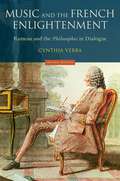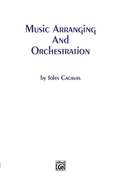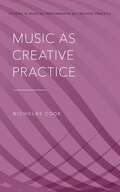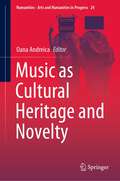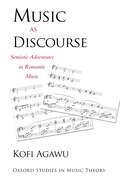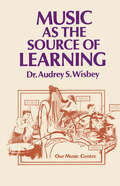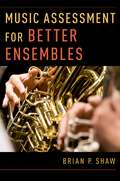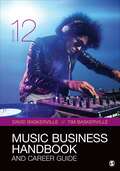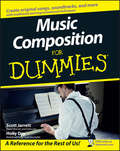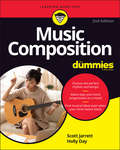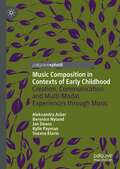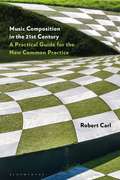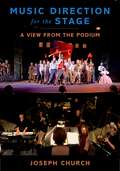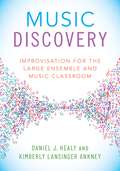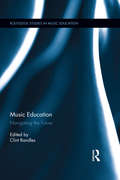- Table View
- List View
Music and the French Enlightenment: Rameau and the Philosophes in Dialogue
by Cynthia VerbaAround the middle of the eighteenth century, the leading figures of the French Enlightenment engaged in a philosophical debate about the nature of music. The principal participants-Rousseau, Diderot, and d'Alembert-were responding to the views of the composer-theorist Jean-Philippe Rameau, who was both a participant and increasingly a subject of controversy. The discussion centered upon three different events occurring roughly simultaneously. The first was Rameau's formulation of the principle of the fundamental bass, which explained the structure of chords and their progression. The second was the writing of the Encyclopédie, edited by Diderot and d'Alembert, with articles on music by Rousseau. The third was the "Querelle des Bouffons," over the relative merits of Italian comic opera and French tragic opera. The philosophes, in the typical manner of Enlightenment thinkers, were able to move freely from the broad issues of philosophy and criticism, to the more technical questions of music theory, considering music as both art and science. Their dialogue was one of extraordinary depth and richness and dealt with some of the most fundamental issues of the French Enlightenment. In the newly revised edition of Music and the French Enlightenment, Cynthia Verba updates this fascinating story with the prolific scholarship that has emerged since the book was first published. Stressing the importance of seeing the philosophes' writings in context of a dynamic dialogue, Verba carefully reconstructs the chain of arguments and rebuttals across which Rousseau, D'Alembert, and Diderot formulated their own evolving positions. A section of key passages in translation presents several texts in English for the first time, recapturing the tenor and tone of the dialogue at hand. In a new epilogue, Verba discusses important trends in new scholarship, tracing how scholars continue to grapple with many of the same fundamental oppositions and competing ideas that were debated by the philosophes in the French Enlightenment.
Music and the French Enlightenment: Rameau and the Philosophes in Dialogue
by Cynthia VerbaAround the middle of the eighteenth century, the leading figures of the French Enlightenment engaged in a philosophical debate about the nature of music. The principal participants-Rousseau, Diderot, and d'Alembert-were responding to the views of the composer-theorist Jean-Philippe Rameau, who was both a participant and increasingly a subject of controversy. The discussion centered upon three different events occurring roughly simultaneously. The first was Rameau's formulation of the principle of the fundamental bass, which explained the structure of chords and their progression. The second was the writing of the Encyclopédie, edited by Diderot and d'Alembert, with articles on music by Rousseau. The third was the "Querelle des Bouffons," over the relative merits of Italian comic opera and French tragic opera. The philosophes, in the typical manner of Enlightenment thinkers, were able to move freely from the broad issues of philosophy and criticism, to the more technical questions of music theory, considering music as both art and science. Their dialogue was one of extraordinary depth and richness and dealt with some of the most fundamental issues of the French Enlightenment. In the newly revised edition of Music and the French Enlightenment, Cynthia Verba updates this fascinating story with the prolific scholarship that has emerged since the book was first published. Stressing the importance of seeing the philosophes' writings in context of a dynamic dialogue, Verba carefully reconstructs the chain of arguments and rebuttals across which Rousseau, D'Alembert, and Diderot formulated their own evolving positions. A section of key passages in translation presents several texts in English for the first time, recapturing the tenor and tone of the dialogue at hand. In a new epilogue, Verba discusses important trends in new scholarship, tracing how scholars continue to grapple with many of the same fundamental oppositions and competing ideas that were debated by the philosophes in the French Enlightenment.
Music Arranging And Orchestration
by John CacavasOrchestrating is a highly complex technique and to many, even those with academic training, a mystery fraught with a labyrinth of hazards. What is required, along with innate talent and general musicality, is the practical "know how." This is hard to achieve without actual professional experience and contact with "live" orchestras. To this end, John Cacavas contributes his extensive experience and ability with a practical approach to the practical problems of orchestrating. It is in this context most orchestrators must function, and to whom this book should be of benefit. The author has been a "musical activist" in all the varied aspects of instrumental combination from the "classical" to the "contemporary," and in the diverse application of his skills in all the media that utilize music and "orchestrations."
Music as Creative Practice (Studies in Musical Perf as Creative Prac)
by Nicholas CookUntil recently, ideas of creativity in music revolved around composers in garrets and the lone genius. But the last decade has witnessed a sea change: musical creativity is now overwhelmingly thought of in terms of collaboration and real-time performance. Music as Creative Practice is a first attempt to synthesize both perspectives. It begins by developing the idea that creativity arises out of social interaction-of which making music together is perhaps the clearest possible illustration-and then shows how the same thinking can be applied to the ostensively solitary practices of composition. The book also emphasizes the contextual dimensions of musical creativity, ranging from the prodigy phenomenon, long-term collaborative relationships within and beyond the family, and creative learning to the copyright system that is supposed to incentivize creativity but is widely seen as inhibiting it. Music as Creative Practice encompasses the classical tradition, jazz and popular music, and music emerges as an arena in which changing concepts of creativity-from the old myths about genius to present-day sociocultural theory-can be traced with particular clarity. The perspective of creativity tells us much about music, but the reverse is also true, and this fifth and last instalment of the Studies in Musical Performance as Creative Practice series offers an approach to musical creativity that is attuned to the practices of both music and everyday life.
Music as Creative Practice (Studies in Musical Perf as Creative Prac)
by Nicholas CookUntil recently, ideas of creativity in music revolved around composers in garrets and the lone genius. But the last decade has witnessed a sea change: musical creativity is now overwhelmingly thought of in terms of collaboration and real-time performance. Music as Creative Practice is a first attempt to synthesize both perspectives. It begins by developing the idea that creativity arises out of social interaction-of which making music together is perhaps the clearest possible illustration-and then shows how the same thinking can be applied to the ostensively solitary practices of composition. The book also emphasizes the contextual dimensions of musical creativity, ranging from the prodigy phenomenon, long-term collaborative relationships within and beyond the family, and creative learning to the copyright system that is supposed to incentivize creativity but is widely seen as inhibiting it. Music as Creative Practice encompasses the classical tradition, jazz and popular music, and music emerges as an arena in which changing concepts of creativity-from the old myths about genius to present-day sociocultural theory-can be traced with particular clarity. The perspective of creativity tells us much about music, but the reverse is also true, and this fifth and last instalment of the Studies in Musical Performance as Creative Practice series offers an approach to musical creativity that is attuned to the practices of both music and everyday life.
Music as Cultural Heritage and Novelty (Numanities - Arts and Humanities in Progress #24)
by Oana AndreicaThis book provides a multifaceted view on the relation between the old and the new in music, between tradition and innovation. This is a much-debated issue, generating various ideas and theories, which rarely come to unanimous conclusions. Therefore, the book offers diverse perspectives on topics such as national identities, narrative strategies, the question of musical performance and musical meaning. Alongside themes of general interest, such as classical repertoire, the music of well-established composers and musical topics, the chapters of the book also touch on specific, but equally interesting subjects, like Brazilian traditions, Serbian and Romanian composers and the lullaby. While the book is mostly addressed to researchers, it can also be recommended to students in musicology, ethnomusicology, musical performance, and musical semiotics.
Music as Discourse: Semiotic Adventures in Romantic Music (Oxford Studies in Music Theory)
by Kofi AgawuThe question of whether music has meaning has been the subject of sustained debate ever since music became a subject of academic inquiry. Is music a language? Does it communicate specific ideas and emotions? What does music mean, and how does this meaning occur? Kofi Agawu's Music as Discourse has become a standard and definitive work in musical semiotics. Working at the nexus of musicology, ethnomusicology, and music philosophy and aesthetics, Agawu presents a synthetic and innovative approach to musical meaning which argues deftly for the thinking of music as a discourse in itself--composed not only of sequences of gestures, phrases, or progressions, but rather also of the very philosophical and linguistic props that enable the analytical formulations made about music as an object of study. The book provides extensive demonstration of the pertinence of a semiological approach to understanding the fully-freighted language of romantic music, stresses the importance of a generative approach to tonal understanding, and provides further insight into the analogy between music and language. Music as Discourse is an essential read for all who are interested in the theory, analysis and semiotics of music of the romantic period.
Music as Discourse: Semiotic Adventures in Romantic Music (Oxford Studies in Music Theory)
by Kofi AgawuThe question of whether music has meaning has been the subject of sustained debate ever since music became a subject of academic inquiry. Is music a language? Does it communicate specific ideas and emotions? What does music mean, and how does this meaning occur? Kofi Agawu's Music as Discourse has become a standard and definitive work in musical semiotics. Working at the nexus of musicology, ethnomusicology, and music philosophy and aesthetics, Agawu presents a synthetic and innovative approach to musical meaning which argues deftly for the thinking of music as a discourse in itself--composed not only of sequences of gestures, phrases, or progressions, but rather also of the very philosophical and linguistic props that enable the analytical formulations made about music as an object of study. The book provides extensive demonstration of the pertinence of a semiological approach to understanding the fully-freighted language of romantic music, stresses the importance of a generative approach to tonal understanding, and provides further insight into the analogy between music and language. Music as Discourse is an essential read for all who are interested in the theory, analysis and semiotics of music of the romantic period.
Music as the Source of Learning: Consultant in Early Childhood and Remedial Education and Educational Technology
by A.S. WisbeyThe evidence grows daily that much learning failure results from undetected early childhood hearing problems (Gordon 1977). This is because the child is deprived of the state of acute hearing sensitivity normally present at birth which makes it possible to recognize the loudness levels and duration of each individual sound. This is how a child learns the signifi cance of the slightest variations in the quality of each sound as he collects information from the environment through all his senses, and the meaning of these changes is experienced and understood. As a result of normal sensory experience and reaction with the environment the multisensory systems are used and developed. Similarly, the growth of the brain is stimulated to make possible the storage of infor mation and to produce the biochemical state necessary to transmit and relate the sensory information so collected and stored (Monckeberg and Prescott, 1975). If the loudness level of sound is reduced so too is its impact. In this form a baby's normal 'startle response' to a sound, which includes the flickering open of the eyes, is rarely experienced. This response of the eyes is a seeking out of a sound source. The visual localizing of sound sources, leading to the antiCipation of their spatial position, arises from the ability to hear the fine changes of pitch and loudness levels involved in movement.
Music Assessment for Better Ensembles
by Brian P. ShawAssessment is central to ensemble music. Yet, teachers do not always have the expertise to harness its potential to improve rehearsals and performances, and promote and document student learning. Written specifically for band, choir, and orchestra teachers at all levels, this book contains all of the information necessary to design and use assessment in a thriving music classroom. The first section addresses foundations such as learning targets, metacognition, and growth mindset. Assessment jargon such as formative assessment, summative assessment, Assessment for Learning, self and peer assessment, and authentic assessment is clarified and illustrated with music examples. Readers will learn practical strategies for choosing which concepts to assess, which methods to use, and how to use results to provide accurate and effective feedback to students. The second section brings assessment fundamentals into the music room. Filled with practical advice, each chapter examines a different facet of musicianship. Sample assessments in all performance areas are provided, including music literacy, fundamentals and technique, terminology, interpretation, evaluation and critique, composition and improvisation, beliefs and attitudes, and more. There is an entire chapter devoted to tips for applying assessment and feedback strategies in rehearsals, which can result in a fresh and effective approach to performance preparation. The final section is an examination of grading practices in music classes. Readers will gain information about ensemble grades that communicate what students know and are able to do, rather than whether they remembered their black socks. A variety of approaches, including Standards-Based Grading, are evaluated in light of music teachers' unique situations. The book concludes with ways for music educators to take their first steps toward implementing these strategies in their own teaching, including the use of instructional technology. Assessing like an expert is possible, and this book is just what teachers need to get started.
Music Assessment for Better Ensembles
by Brian P. ShawAssessment is central to ensemble music. Yet, teachers do not always have the expertise to harness its potential to improve rehearsals and performances, and promote and document student learning. Written specifically for band, choir, and orchestra teachers at all levels, this book contains all of the information necessary to design and use assessment in a thriving music classroom. The first section addresses foundations such as learning targets, metacognition, and growth mindset. Assessment jargon such as formative assessment, summative assessment, Assessment for Learning, self and peer assessment, and authentic assessment is clarified and illustrated with music examples. Readers will learn practical strategies for choosing which concepts to assess, which methods to use, and how to use results to provide accurate and effective feedback to students. The second section brings assessment fundamentals into the music room. Filled with practical advice, each chapter examines a different facet of musicianship. Sample assessments in all performance areas are provided, including music literacy, fundamentals and technique, terminology, interpretation, evaluation and critique, composition and improvisation, beliefs and attitudes, and more. There is an entire chapter devoted to tips for applying assessment and feedback strategies in rehearsals, which can result in a fresh and effective approach to performance preparation. The final section is an examination of grading practices in music classes. Readers will gain information about ensemble grades that communicate what students know and are able to do, rather than whether they remembered their black socks. A variety of approaches, including Standards-Based Grading, are evaluated in light of music teachers' unique situations. The book concludes with ways for music educators to take their first steps toward implementing these strategies in their own teaching, including the use of instructional technology. Assessing like an expert is possible, and this book is just what teachers need to get started.
Music Business Handbook And Career Guide (PDF)
by David Baskerville Timothy BaskervilleThe Twelfth Edition of this powerhouse best-selling text maintains its tradition as the most comprehensive, up-to-date guide to the music industry in all of its diversity. Readers new to the music business and seasoned professionals alike will find David Baskerville and Tim Baskerville’s handbook the go-to source, regardless of their specialty within the music field. Music Business Handbook and Career Guide is ideal for introductory courses such as Introduction to the Music Business, Music and Media, and other survey courses as well as more specialized courses such as the record industry, music careers, artist management, and more. The fully updated Twelfth Edition includes a comprehensive discussion of the streaming revolution and its impact on all parts of the value chain, including composers, performing artists, publishers, and labels. The book also analyzes shifts in the competing platforms of consumption ranging from fast-shrinking physical formats and broadcasting to downloads and subscription services. This edition offers more vignettes than ever, illustrating how individuals in different industry roles advanced their careers, as well as how they’ve adjusted to the intertwining influences of technology, law, and culture.
Music Composition For Dummies
by Holly Day Scott JarrettCreate the next big pop hit, bang out a catchy jingle, or write an iconic film score, with music composition skills Today's composers create music for television, film, commercials, and even video games. Music Composition For Dummies brings you up to speed with the theory and technicality of composing music. With easy-to-understand content that tracks to a typical music composition intro course, this book will teach you how to use music theory to write music in a variety of forms. You'll discover the latest tech tools for composers, including composing software and online streaming services where you can publish your musical creations. And you'll get a rundown on the world of intellectual property, so you can collab and remix fairly, while retaining all the rights to your own creations. Get a clear introduction to music theory and songwriting concepts Learn about composition best practices for movies, TV, video games, and beyond Explore sample music to help you understand both artistic and commercial composition Launch into the latest technologies to mix and share your creations Great for music students and aspiring artists, Music Composition For Dummies, is an easy-to-read guide to writing and producing all kinds of tunes.
Music Composition For Dummies
by Holly Day Scott JarrettCreate the next big pop hit, bang out a catchy jingle, or write an iconic film score, with music composition skills Today's composers create music for television, film, commercials, and even video games. Music Composition For Dummies brings you up to speed with the theory and technicality of composing music. With easy-to-understand content that tracks to a typical music composition intro course, this book will teach you how to use music theory to write music in a variety of forms. You'll discover the latest tech tools for composers, including composing software and online streaming services where you can publish your musical creations. And you'll get a rundown on the world of intellectual property, so you can collab and remix fairly, while retaining all the rights to your own creations. Get a clear introduction to music theory and songwriting concepts Learn about composition best practices for movies, TV, video games, and beyond Explore sample music to help you understand both artistic and commercial composition Launch into the latest technologies to mix and share your creations Great for music students and aspiring artists, Music Composition For Dummies, is an easy-to-read guide to writing and producing all kinds of tunes.
Music Composition For Dummies
by Scott Jarrett Holly DayWant to turn that haunting tune in your head into an awesome sound in your ear? You can! Music Composition For Dummies demystifies the process of composing music and writing songs. It guides you through every step of writing your own music, from choosing the right rhythm and tempo to creating melodies and chord progressions and working with instruments and voices. In this fun and practical guide, you’ll learn how to match keys and chords to the mood you want to convey, work a form without limiting your creativity, and hammer out a musical idea, even when your mind is drawing a blank. You’ll find out how to create popular songs, classically structured pieces, and even film, TV, and video game soundtracks. And, you’ll learn what you need to know about music composition software, including Finale, Sebelius, Pro Tools, and more. Discover how to: Preserve and organize your musical ideas Work with established chord progressions or create your own Develop great rhythms Select the right instruments Find melodies in your head, your instrument, and the world around you Use major and minor scales Work with modes and moods Build melodic motifs and phrases Use the circle of fifths to harmonize Write for multiple voices Make a demo recording Filled with creative exercises to build your composing skills, Music Composition for Dummies is the resource you need to get that melody out of your head and into the world.
Music Composition For Dummies
by Scott Jarrett Holly DayYou can hum it, but can you write it down? When most people think of a composer, they picture a bewigged genius like Mozart or Beethoven frenetically directing mighty orchestras in the ornate palaces of Vienna. While that may have been the case once upon a time, modern composers make themselves heard far beyond the classical conservatoire and concert hall. These days, soundtracks are in high demand in industries such as TV, film, advertising, and even gaming to help create immersive and exciting experiences. Whatever your musical ambitions—composing a dark requiem in a beautiful Viennese apartment or producing the next great Star Wars-like movie theme in LA—the fully updated Music Composition For Dummies hits all the right notes to help you become confident in the theory and practice of composition. To help you translate your musical ideas from fleeting tunes in your head to playable bars and notation on paper, professional composer and instructor Scott Jarrett and music journalist Holly Day take you on a friendly step-by-step journey through the process of musical creation, including choosing the right rhythms and tempos, creating melodies and chord progressions, and working with instruments and voices. You’ll learn how to match keys and chords to mood, use form to enhance your creativity, and write in different styles from pop to classical—and you’ll even learn how to keep hammering away when inspiration eludes you. Organize and preserve your musical ideas Formalize your knowledge with professional vocabulary Get familiar with composition apps and software Make a demo and market on social media Filled with musical exercises to help you acquire the discipline you need for success, Music Composition For Dummies has everything you need to turn your inner soundtrack into a tuneful reality!
Music Composition For Dummies
by Scott Jarrett Holly DayYou can hum it, but can you write it down? When most people think of a composer, they picture a bewigged genius like Mozart or Beethoven frenetically directing mighty orchestras in the ornate palaces of Vienna. While that may have been the case once upon a time, modern composers make themselves heard far beyond the classical conservatoire and concert hall. These days, soundtracks are in high demand in industries such as TV, film, advertising, and even gaming to help create immersive and exciting experiences. Whatever your musical ambitions—composing a dark requiem in a beautiful Viennese apartment or producing the next great Star Wars-like movie theme in LA—the fully updated Music Composition For Dummies hits all the right notes to help you become confident in the theory and practice of composition. To help you translate your musical ideas from fleeting tunes in your head to playable bars and notation on paper, professional composer and instructor Scott Jarrett and music journalist Holly Day take you on a friendly step-by-step journey through the process of musical creation, including choosing the right rhythms and tempos, creating melodies and chord progressions, and working with instruments and voices. You’ll learn how to match keys and chords to mood, use form to enhance your creativity, and write in different styles from pop to classical—and you’ll even learn how to keep hammering away when inspiration eludes you. Organize and preserve your musical ideas Formalize your knowledge with professional vocabulary Get familiar with composition apps and software Make a demo and market on social media Filled with musical exercises to help you acquire the discipline you need for success, Music Composition For Dummies has everything you need to turn your inner soundtrack into a tuneful reality!
Music Composition in Contexts of Early Childhood: Creation, Communication and Multi-Modal Experiences through Music
by Jan Deans Berenice Nyland Aleksandra Acker Kylie Payman Suzana KlarinThis book explores the narratives of a group of four-year-old children in a composition project in an Australian early learning centre. The participants, centre staff and a composer, Stephen Leek, contributed a number of music sessions for the children, including five original songs. The book showcases young children’s communicative ability and sensitivity to wider issues. The staff in the centre have a strongly voiced philosophy that is enacted through arts-based pedagogy and incorporates significant themes including a respect for Aboriginal culture and custodial responsibility towards a sustainable future for the earth. Examples of adult and children’s ideas are illustrated through music making, singing, dancing, words, drawings and paintings, which provide insights into a world where children are viewed as active citizens and the arts have rights. The book describes the context of the centre, the history of projects and details one project as an example of “lifeworthy learning”.
Music Composition in the 21st Century: A Practical Guide for the New Common Practice
by Robert CarlThe state of contemporary music is dizzyingly diverse in terms of style, media, traditions, and techniques. How have trends in music developed over the past decades? Music Composition in the 21st Century is a guide for composers and students that helps them navigate the often daunting complexity and abundance of resources and influences that confront them as they work to achieve a personal expression.From pop to classical, the book speaks to the creative ways that new composers mix and synthesize music, creating a music that exists along a more continuous spectrum rather than in a series of siloed practices. It pays special attention to a series of critical issues that have surfaced in recent years, including harmony, the influence of minimalism, the impact of technology, strategies of "openness," sound art, collaboration, and improvisation. Robert Carl identifies an emerging common practice that allows creators to make more informed aesthetic and technical decisions and also fosters an inherently positive approach to new methods.
Music Composition in the 21st Century: A Practical Guide for the New Common Practice
by Robert CarlThe state of contemporary music is dizzyingly diverse in terms of style, media, traditions, and techniques. How have trends in music developed over the past decades? Music Composition in the 21st Century is a guide for composers and students that helps them navigate the often daunting complexity and abundance of resources and influences that confront them as they work to achieve a personal expression.From pop to classical, the book speaks to the creative ways that new composers mix and synthesize music, creating a music that exists along a more continuous spectrum rather than in a series of siloed practices. It pays special attention to a series of critical issues that have surfaced in recent years, including harmony, the influence of minimalism, the impact of technology, strategies of "openness," sound art, collaboration, and improvisation. Robert Carl identifies an emerging common practice that allows creators to make more informed aesthetic and technical decisions and also fosters an inherently positive approach to new methods.
MUSIC DIRECTION FOR STAGE C: A View from the Podium
by Joseph ChurchTheater music directors must draw on a remarkably broad range of musical skills. Not only do they conduct during rehearsals and performances, but they must also be adept arrangers, choral directors, vocal coaches, and accompanists. Like a record producer, the successful music director must have the flexibility to adjust as needed to a multifaceted job description, one which changes with each production and often with each performer. In Music Direction for the Stage, veteran music director and instructor Joseph Church demystifies the job in a book that offers aspiring and practicing music directors the practical tips and instruction they need in order to mount a successful musical production. Church, one of Broadway's foremost music directors, emerges from the orchestra pit to tell how the music is put into a musical show. He gives particular attention to the music itself, explaining how a music director can best plan the task of learning, analyzing, and teaching each new piece. Based on his years of professional experience, he offers a practical discussion of a music director's methods of analyzing, learning, and practicing a score, thoroughly illustrated by examples from the repertoire. The book also describes how a music director can effectively approach dramatic and choreographic rehearsals, including key tips on cueing music to dialogue and staging, determining incidental music and underscoring, making musical adjustments and revisions in rehearsal, and adjusting style and tempo to performers' needs. A key theme of the book is effective collaboration with other professionals, from the production team to the creative team to the performers themselves, all grounded in Church's real-world experience with professional, amateur, and even student performances. He concludes with a look at music direction as a career, offering invaluable advice on how the enterprising music director can find work and gain standing in the field.
Music Direction for the Stage: A View from the Podium
by Joseph ChurchTheater music directors must draw on a remarkably broad range of musical skills. Not only do they conduct during rehearsals and performances, but they must also be adept arrangers, choral directors, vocal coaches, and accompanists. Like a record producer, the successful music director must have the flexibility to adjust as needed to a multifaceted job description, one which changes with each production and often with each performer. In Music Direction for the Stage, veteran music director and instructor Joseph Church demystifies the job in a book that offers aspiring and practicing music directors the practical tips and instruction they need in order to mount a successful musical production. Church, one of Broadway's foremost music directors, emerges from the orchestra pit to tell how the music is put into a musical show. He gives particular attention to the music itself, explaining how a music director can best plan the task of learning, analyzing, and teaching each new piece. Based on his years of professional experience, he offers a practical discussion of a music director's methods of analyzing, learning, and practicing a score, thoroughly illustrated by examples from the repertoire. The book also describes how a music director can effectively approach dramatic and choreographic rehearsals, including key tips on cueing music to dialogue and staging, determining incidental music and underscoring, making musical adjustments and revisions in rehearsal, and adjusting style and tempo to performers' needs. A key theme of the book is effective collaboration with other professionals, from the production team to the creative team to the performers themselves, all grounded in Church's real-world experience with professional, amateur, and even student performances. He concludes with a look at music direction as a career, offering invaluable advice on how the enterprising music director can find work and gain standing in the field.
Music Discovery: Improvisation for the Large Ensemble and Music Classroom
by Daniel J. Healy Kimberly Lansinger AnkneyImprovisation is a boundless and exciting way to experience music, especially for students. Teachers increasingly agree that improvisation is an essential skill for students to learn - however, many are unsure how to productively incorporate it in the classroom. Furthermore, most improvisational practices are centered around jazz, with very little to help even classical and vocal ensembles let alone the general music classroom. Now, in this new book, Daniel Healy and Kimberly Lansinger Ankney offer a practical volume aimed at busy music teachers. Recognizing educators' desire to balance the standard curriculum with improvisational activities, the authors provide 36 activities to incorporate into their everyday music classes and ensemble practices. All activities are flexibly designed in styles ranging from modern classical to pop. Teachers can spend anywhere from 5 minutes to an entire term on a single activity, in a variety of environments and ensembles - concert bands, orchestras, choirs, jazz ensembles, and music technology classes alike can benefit from the practices of improvisation. Aligning improvisation practices with the constraints of the classroom, the lessons focus on key music learning principles (melody, harmony, rhythm, texture/timbre, articulation, and dynamics), allowing students' basic performance skills to develop in conjunction with their improvisational ones. The book also comes with a companion website which provides helpful resources for teachers, including recordings of actual K-12 ensembles performing the improvisation activities. Designed for a wide range of ages and experience levels, Music Discovery: Improvisation for the Large Ensemble and Music Classroom is the first practical guide of its kind, and gives teachers a long-awaited jumping-off point to introduce this playful, thrilling, and vital musical practice to their students.
MUSIC DISCOVERY C: Improvisation for the Large Ensemble and Music Classroom
by Daniel J. Healy Kimberly Lansinger AnkneyImprovisation is a boundless and exciting way to experience music, especially for students. Teachers increasingly agree that improvisation is an essential skill for students to learn - however, many are unsure how to productively incorporate it in the classroom. Furthermore, most improvisational practices are centered around jazz, with very little to help even classical and vocal ensembles let alone the general music classroom. Now, in this new book, Daniel Healy and Kimberly Lansinger Ankney offer a practical volume aimed at busy music teachers. Recognizing educators' desire to balance the standard curriculum with improvisational activities, the authors provide 36 activities to incorporate into their everyday music classes and ensemble practices. All activities are flexibly designed in styles ranging from modern classical to pop. Teachers can spend anywhere from 5 minutes to an entire term on a single activity, in a variety of environments and ensembles - concert bands, orchestras, choirs, jazz ensembles, and music technology classes alike can benefit from the practices of improvisation. Aligning improvisation practices with the constraints of the classroom, the lessons focus on key music learning principles (melody, harmony, rhythm, texture/timbre, articulation, and dynamics), allowing students' basic performance skills to develop in conjunction with their improvisational ones. The book also comes with a companion website which provides helpful resources for teachers, including recordings of actual K-12 ensembles performing the improvisation activities. Designed for a wide range of ages and experience levels, Music Discovery: Improvisation for the Large Ensemble and Music Classroom is the first practical guide of its kind, and gives teachers a long-awaited jumping-off point to introduce this playful, thrilling, and vital musical practice to their students.
Music Education: Navigating the Future (Routledge Studies in Music Education #1)
by Clint RandlesEducation involving music is a multifaceted and ever-altering challenge. As new media, technologies, and pedagogies are developed, academics and practitioners must make sure that they are aware of current trends and where they might lead. This book features studies on the future of music education from emerging scholars in the field. These studies are then supplemented by commentaries from established leaders of the music education community. Music Education covers topics such as music and leisure, new forms of media in music teaching and learning, the role of technology in music learning, popular music tuition in the expansion of curricular offering, and assessment of music education research. As such, it is an excellent reference for scholars and teachers as well as guide to the future of the discipline.
